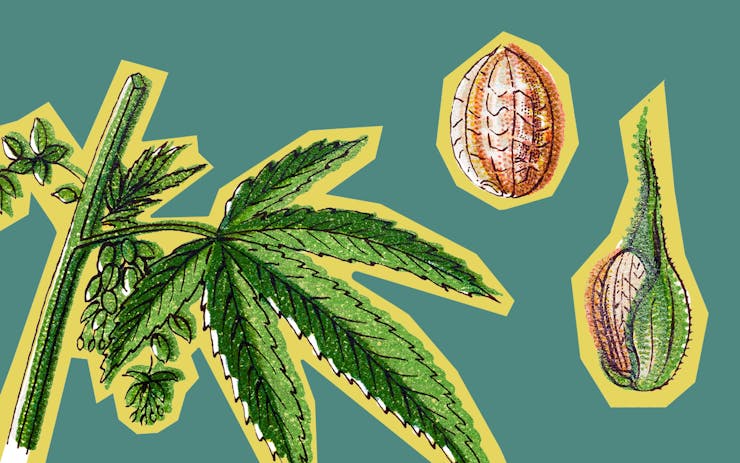While browsing Leafly’s strain database, you may wonder what a cross of this and that strain is, what a hybrid or a backcross is, or what a parent strain is. All of these have to do with plant breeding—essentially, breeding a male and female plant to combine or refine the genetics of two plants or strains. Breeding two different strains often results in a new strain or hybrid.
Cannabis breeders typically breed to purify and strengthen strains, combine strain traits, or enhance specific characteristics.
Cannabis breeders typically breed to purify and strengthen strains, combine strain traits, or enhance specific characteristics like higher yields, specific aromas, potency, and many other things.
When growing and breeding, it’s important to know where your seeds come from and what kind of genetics they have. If the seed breeder can’t give you a detailed history of how a packet of seeds was bred or what they were crossed with, you never really know what you’re getting.
Plant breeding is a fundamental process of growing cannabis. Breeding is highly technical and typically done on a commercial scale, but with legalization increasing, breeding is becoming more popular. You can even do it yourself.
The Basics of Breeding
Cannabis plants can be either male or female. Cannabis consumers are mainly concerned with female plants, because only females produce the sticky buds that we all know and love. But male cannabis plants are important for the breeding process, as they are needed to pollinate the bud-producing females.
Take the strain Super Lemon Haze as an example. It’s a hybrid (or a “cross”) of Super Silver Haze and Lemon Skunk—these are the parent strains. At some point, the breeder decided that they liked some attributes of Super Silver Haze and some of Lemon Skunk and decided to combine the two.
To do this, you need a male of one strain to pollinate a female of the other. Once pollinated, the female will then produce seeds that express the genes of both the male and female plant. Those seeds will be harvested and grown separately, and voilà: You have created a hybrid.
So how do you know whether to pick a male or a female of each strain that you’re crossing?
“Often in cannabis, the traits of the female carry over to progeny (seeds) more than the male. That said, the traits of the male are often obvious to the discerning grower so one should definitely choose a male that will complement the traits of the female,” says Nat Pennington, founder and CEO of Humboldt Seed Company who’s been breeding cannabis for 20 years. “So much is possible with truly intentional breeding strategies.”
How to Breed Cannabis Plants
After two parent strains are selected for breeding, a male and several females are put into a breeding chamber to contain the pollen. A breeding chamber can be as simple as an enclosed environment with plastic sheeting on the sides, or a specially designed sterile environment for large-scale breeding.
“A healthy male can pollinate up to 20 females, and by pollinate, I mean absolutely cover the plant with seeds.”
A single male plant can pollinate tens of females. “It’s always a good idea to have only one male, genetically speaking, per pollination effort,” says Pennington. “A healthy male can pollinate up to 20 females, and by pollinate, I mean absolutely cover the plant with seeds.”
This is intentional breeding—any grower who’s accidentally grown a male and pollinated a crop will know that one male can easy pollinate hundreds of females, filling your whole crop with seeds.
Shop highly rated dispensaries near you
Showing you dispensaries nearOnce in the breeding chamber, you can grow the plants vegetatively for a few weeks to let them get bigger, but it’s not necessary. Put them on a flowering light cycle: 12 hours of light, 12 hours of dark.
The mature male will grow pollen sacs within the first couple weeks of its flowering phase. Pollen will release from the sacs, move through the air, and land on the female plants, pollinating them. Having an enclosed breeding chamber is important to contain the pollen and also to prevent outside pollen from getting in.
You can also help along the pollination effort by shaking pollen from the male onto the females, or by collecting pollen from the male and directly applying it to the females. These female plants will continue to grow and flower, during which they’ll grow seeds (as well as buds). These seeds will express the genetics of both the male and female plant.
When the seeds are mature, they are harvested and stratified (or dried). “The secondary process of maturation happens after the plant is dead, and the seed needs to be stratified before it will germinate,” says Pennington. “In general, harvest for flower takes place three to four weeks before harvest for seed.”
These seeds—now a hybrid of the two parent strains—will be grown on their own, outside of the breeding environment.
Phenotypes
But the process doesn’t end there. The hybrid strain that you buy at the dispensary has likely gone through many rounds—or generations—of breeding to strengthen its genes and to ensure that its descendants are healthy and consistent.
Just as you and your sibling might have different physical attributes from your parents, each seed created from a round of cross-pollination will have different attributes from its parent strains. Maybe you have your father’s eyes and your mother’s hair, but your sister has your mother’s eyes and hair. Each cannabis seed is unique and will express different traits, and different combinations of traits, from one or both of the parent strains. These seeds with various expressions are called phenotypes.
Homozygosity ensures that a plant will consistently produce the same seeds with the same genetic makeup over and over again.
A plant that produces a set of phenotypes that have a lot of variety are said to be heterozygous. With cannabis, you typically want seeds that are homozygous—ones that have the same set of genes. Homozygosity ensures that a plant will consistently produce the same seeds with the same genetic makeup over and over again, ensuring that buyers and consumers will get the same plant or seed time and again.
After a strain is crossed, a breeder will then have to select which phenotype of the new strain they like best. For large-scale growers, they want to choose the best phenotype for mass production.
Back to the Super Lemon Haze example: This strain takes a lot of its bud structure, trichome and resin production, and overall appearance from Super Silver Haze. But it takes its flavors and aromas from Lemon Skunk.
Lemon Skunk also tends to grow extremely tall and has loose buds, whereas Super Silver Haze grows smaller and has denser buds. Through selecting specific phenotypes, a breeder can pick one that has the attributes they want to keep. In this case, a phenotype that has the structure and bud density of Super Silver Haze and the flavors and aromas of Lemon Skunk.
Most likely, there were early phenotypes of Super Lemon Haze that grew tall and loose like Lemon Skunk, or tasted more like Super Silver Haze. But the breeder discarded those phenotypes and keep growing the ones that have the attributes of what we now know is Super Lemon Haze.
Backcrossing
High-quality breeding still doesn’t stop there. Once a breeder has crossed a strain and narrowed down a phenotype and finally has the one, they will usually backcross that strain to strengthen its genetics.
Backcrossing is a practice where a breeder will cross-pollinate the new strain with itself or a parent—essentially, inbreeding the strain. This makes the strain more homozygous, and strengthens its genetics and desirable characteristics, and also ensures that those genes continue to pass down from generation to generation.
The hybrid that you bought from the dispensary has gone through months and even years of growing, crossing, and backcrossing, as well as a selection process to pick the best phenotype of that strain.
Breeding is about time and patience. Says Pennington: “To be a breeder, you have to be willing to accept the fact that you won’t have uniformity in the offspring, [you’ll get] lots of ugly ducklings in the hunt for your golden goose. To make seeds that will actually reflect the golden goose takes time, and it takes more than just a one-off cross. Even after you found your golden goose, expect to have to do a whole number of stabilizing backcrosses to reproduce your golden goose in seed form.”





